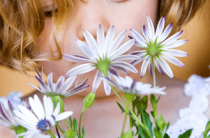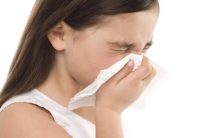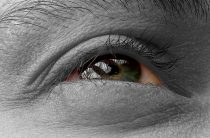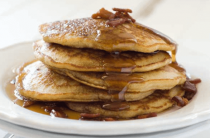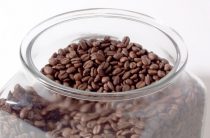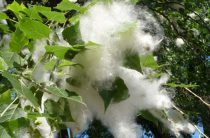Warm spring sunshine awakens all nature. Plants begin to bloom, delight our eyes, improve our mood. But, unfortunately, not everyone is happy with this phenomenon. According to medical statistics, approximately thirty percent of the entire population of the planet is allergic to flowering plants. Cases of morbidity are recorded especially often among the inhabitants of highly developed countries.
Allergy is a common disease nowadays. Its most popular variety is pollinosis, or hay fever. This disease is caused by the pollen of certain plants.
The most common symptoms of a flower allergy are:
- allergic rhinitis. It immediately manifests itself as a sensation of itching in the nasal passages, after which watery transparent mucus begins to stand out from them, sneezing, nasal congestion begins, due to which the sense of smell is significantly reduced. In babies, these symptoms can be supplemented by hearing loss, pain and tinnitus.
- Allergic conjunctivitis. Its manifestations are redness of the eyes, strong tearing from them, swelling of the conjunctiva, a feeling of sand in the eyes, and the absence of purulent formations.
- Bronchial asthma. Quite often, a person has asthma attacks.
- Eruptions on the skin. The patient may develop urticaria, Quincke's edema, seasonal dermatitis, which is complemented by severe itching, and other rashes.
- Nervousness. The patient becomes very irritable, quickly tired, tearful, his sleep is disturbed.
- Increase in body temperature. A person can sometimes be shivering, due to the fact that his organs and systems are affected.
Accurately diagnose the presence of an allergy to flowering will help one of the most striking signs of this disease - its seasonality. Symptoms come and go in the same time period, sometimes the duration of the disease changes because there is a shift in flowering plants due to changes in the weather.
It is impossible not to pay due attention to the fact that pollinosis can begin due to the flowering of plants of a certain type: cereals, Compositae, trees. Medicine has not yet fully studied this type of allergy, any person can succumb to its influence.
Causes of hay fever
An inadequate reaction of the body to flowering is provoked by the pollen of flowering plants. Therefore, it is more correct to call this disease “pollen allergy”, and not “flower allergy”. But whatever the name, the essence of the disease remains the same. There are certain types of plants that produce pollen. These plants cause various serious diseases. Pollen is considered the most allergenic:
- Weeds: ragweed wormwood, amaranth or amaranth thrown back, wormwood three-toothed, plantain lanceolate.
- Herbs: meadow bluegrass, meadow timothy grass, meadow bent grass, Aleppo sorghum, hedgehog, fragrant spikelet.
- Trees: ash, oak, walnut, pecan, juniper, ash-leaved maple.
Pollen allergy can be triggered by houseplants such as geranium, ferns, azalea, cyclamen, kalanchoe, alamanda.
Allergy to birch pollen
One of the most common diseases is birch pollen allergy. Urban dwellers are more prone to it than rural ones. This is easily explained by the fact that in the first category of the population, the immune system is weakened by exposure to various kinds of chemicals that are found in large quantities in urban smog.
Not necessarily an allergy to birch occurs in those people. Which are close to its place of growth. Microscopic pollen particles are easily carried by the wind to considerable distances from birch groves.
Causes of Birch Pollen Allergy
The root causes of birch allergy are allergens contained in its pollen, which is formed during its flowering. Birch pollen contains approximately forty protein compounds. Studies of various kinds have made it possible to determine that different symptoms of an intolerance reaction provoke only six of them.
In most people, birch pollen allergy is caused by a glycoprotein.
Harmful proteins are released during the flowering of plants, mainly in our climatic zone in April-May. An allergic reaction is exacerbated during these months of the year. A healthy person does not react in any way to birch pollen, his state of health remains the same.
But when the body produces antibodies to birch pollen, the person begins to suffer from symptoms. The largest concentration of pollen is noted in a birch grove, square, park. Provoke the transfer of allergens and weather factors. In dry and windy weather, a person with an allergy to birch has an exacerbation of symptoms.
Allergics are mainly people who have digestive problems and metabolic disorders in the body. For the first time, such a disease can manifest itself both in childhood and in adulthood.
Symptoms of "birch" allergy
When an allergy to birch occurs, symptoms of the immediate type most often appear.
Most often they appear in humans where there are a lot of flowering trees. The smallest proteins, when they enter the respiratory system and on the mucous membranes of the conjunctiva, cause the following symptoms:
- Itching in the nose, mouth, on the sclera of the eyes;
- The appearance of nasal congestion, severe sneezing, copious secretion of clear mucus from the nose;
- Redness of the conjunctiva of the eyes, their swelling;
- The appearance of profuse lacrimation.
If a large amount of pollen immediately enters the body, then the reaction of the immune system becomes very pronounced. It manifests itself in the form of bronchial asthma, urticaria, febrile symptoms.
In young children, especially those who live in areas with a poor environmental situation, allergy symptoms are very pronounced. Severe intolerance reactions, which include anaphylactic shock, Quincke's edema, suffer very rarely, but they are still quite possible.
Diagnosis of allergy to birch
Allergies to pollen are characterized by fairly pronounced symptoms. Based on clinical manifestations, a preliminary diagnosis can be made. To exclude the influence of other factors, it is necessary to conduct additional survey methods. These tests include blood tests and special skin tests.
They make it possible to understand whether the protein contained in birch pollen is actually allergenic. Also, it does not hurt to conduct blood tests, according to the results of which it will be possible to understand how well the immune system functions.
Treatment of allergic reactions to birch
Due to an allergy to birch, the general condition of a person noticeably worsens, he has a depressed mood and a decrease in working capacity. When the disease is not treated, and the person does not follow any preventive recommendations, the symptoms will only intensify every year, eventually bronchial asthma may develop.
Treatment by an allergist will allow you to achieve a stable and fairly long remission. It is impossible to choose medicines on your own. After all, in this way the symptoms may be weakened, but the disease will not disappear, or even the negative manifestations will intensify.
Like any other, birch pollen allergy is treated by avoiding contact with the allergen. But not everyone has the opportunity to leave their place of residence during the flowering of birch. In this case, the focus is on minimizing exposure to birch pollen, which can be done by:
- Not a long stay in places where there are birches;
- Wearing a protective mask, and when returning home, rinsing the nose, eyes and mouth with plain water;
- Use of home air conditioners, wet cleaning.
Birch pollen spreads more intensively when the weather is dry and windy. Therefore, it is best for allergy sufferers to walk in the evening after rain. When the pollen is nailed to the ground.
For treatment use:
- Antihistamines. They are able to eliminate various symptoms of diseases, they take pills such as Erius, Kestin, Loratadin.
- Vasoconstrictor drops. Kromoheksal drops are often prescribed for instillation of the nose and eyes.
- Asthma drugs. Singulair is used to eliminate asthma attacks. It can be prescribed for both adults and children.
Flower allergy treatment
It is impossible to completely get rid of pollinosis. But it is in our power to take the necessary measures in order to make it less pronounced and improve the patient's condition. Before the beginning of the flowering period, it is necessary to undergo medical treatment, which implies the use of antihistamines, antiallergic drugs. It is forbidden to use them arbitrarily, because only a highly qualified physician can choose the right treatment. The best outcome of self-prescribing drugs will be their uselessness, and the worst - harm to health. In addition, the doctor draws up an individual treatment plan for each patient.
In medicine, hyposensitization is used, with the help of which the patient's body adapts to the allergen. It is carried out as follows: they inject a small amount of the allergen into the body and observe the reaction, if it is mild, continue treatment. Thus, gradually the doses increase, and the body gets used to the allergen, and no longer reacts to it so violently.
Principles of successful treatment of hay fever:
- Elimination, or if this is not possible, minimizing exposure to the allergen.
- Taking medications:
- Antihistamines that do not affect the metabolism or the production of histamine, but only block its receptors.
- Mast cell stabilizers, which include Nedocromil and Cromolyn. They are used when other drugs are ineffective, or are prohibited to the patient. The main purpose of these drugs is to block the released mediators from mast cells.
- Anti-inflammatory drugs that are used orally and intranasally. They help with severe allergic disorders, such as allergic dermatitis, an attack of seasonal asthma.
- Antileukotiene drugs that are used to treat bronchial asthma, seasonal allergic rhinitis.
- Immunotherapy makes it possible to alleviate the patient's condition in the event that drug therapy does not have the desired effect, and it is impossible not to contact the allergen.
Treatment of allergies to pollen folk remedies
You can eliminate seasonal allergies, or achieve a weakening of its symptoms, using folk remedies. If the cause of the disease was the flowering and pollination of various kinds of plants, then when a person returns home from the street, he should gargle and take a shower.
One of the best helpers in the fight against allergies is a decoction of calendula. Pour calendula flowers with 1 cup of boiling water, insist for half an hour, consume several times a day, one tablespoon.
Apply a decoction of medicinal chamomile (one tablespoon of flowers is poured with one glass of boiling water) more than six times a day, one tablespoon. To eliminate eye lesions, it is necessary to drink the juice of meadow clover inflorescences.
Before the start of the allergy season, you should buy honey on the market, and take one teaspoon of it, both as a separate remedy and in addition to tea.
Stinging nettle, which is a natural antihistamine, can relieve seasonal allergies. They do not have any side effects, unlike drugs. The dose of this medicine should not exceed 0.3 kg per day.
The most universal cure for pollinosis is considered to be an infusion of a string. It needs to be consumed for a long time (about five years). Brewing this herb in the form of tea, you need to drink it half an hour after it has been infused. The golden color of the broth indicates its proper preparation and freshness of raw materials. It is better to assemble the grass yourself and dry it in a shady place. The cleansing effect of tea allows a person to quickly get rid of allergies.
Recommendations for a quick cure for allergies
To cure allergies, as soon as possible, you need to follow the following rules:
- Since pollinosis exhausts the body, forcing the immune system to work very intensively, the first thing to do is to eat food that has anti-inflammatory properties.
- A properly functioning digestive system improves immunity. It is necessary to eat foods that are rich in alpha-linolenic acid, such as walnuts, fish oil, flax oil. Prebiotics, the live bacteria found in yoghurts with live cultures, are also helpful. They are able to strengthen the digestive system and immunity.
- Regularly clear the nasal passages, gargle so that the allergens that are on them cannot harm the human body. It is also recommended to do washing with a weak saline solution of the nasal and oral cavities.
- If there is no need, do not go out in the morning in dry, windy and hot weather. After all, the concentration of pollen in the air in the morning is very high.
- Windows and doors in the room should be tightly closed so that pollen cannot get inside. Wet gauze must be hung on the vents. Regular wiping of the floor, window sills, tables will reduce the amount of allergens in the house.
- Drying clothes is best done indoors. Walking along the street is best done in the evening, because at this time the concentration of pollen in the air decreases.
- If you use drops to eliminate allergic rhinitis, then you need to use them only for a well-defined time so that addiction does not occur.
Of course, treating a bloom allergy is not an easy task. But still, if you approach this issue responsibly, thanks to the implementation of simple rules, you can significantly weaken its signs. All you need is to follow the rules of personal hygiene, do wet cleaning quite often, monitor the state of your immunity.
If you have any questions regarding allergies to flowering in adults, you can ask our consultant.


